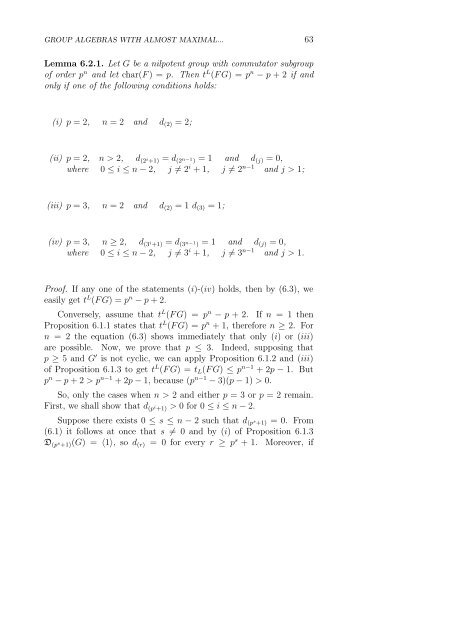On the Derived Length of Lie Solvable Group Algebras
On the Derived Length of Lie Solvable Group Algebras
On the Derived Length of Lie Solvable Group Algebras
Create successful ePaper yourself
Turn your PDF publications into a flip-book with our unique Google optimized e-Paper software.
GROUP ALGEBRAS WITH ALMOST MAXIMAL... 63<br />
Lemma 6.2.1. Let G be a nilpotent group with commutator subgroup<br />
<strong>of</strong> order p n and let char(F ) = p. Then t L (F G) = p n − p + 2 if and<br />
only if one <strong>of</strong> <strong>the</strong> following conditions holds:<br />
(i) p = 2, n = 2 and d(2) = 2;<br />
(ii) p = 2, n > 2, d (2 i +1) = d (2 n−1 ) = 1 and d(j) = 0,<br />
where 0 ≤ i ≤ n − 2, j = 2 i + 1, j = 2 n−1 and j > 1;<br />
(iii) p = 3, n = 2 and d(2) = 1 d(3) = 1;<br />
(iv) p = 3, n ≥ 2, d (3 i +1) = d(3 n−1 ) = 1 and d(j) = 0,<br />
where 0 ≤ i ≤ n − 2, j = 3 i + 1, j = 3 n−1 and j > 1.<br />
Pro<strong>of</strong>. If any one <strong>of</strong> <strong>the</strong> statements (i)-(iv) holds, <strong>the</strong>n by (6.3), we<br />
easily get t L (F G) = p n − p + 2.<br />
Conversely, assume that t L (F G) = p n − p + 2. If n = 1 <strong>the</strong>n<br />
Proposition 6.1.1 states that t L (F G) = p n + 1, <strong>the</strong>refore n ≥ 2. For<br />
n = 2 <strong>the</strong> equation (6.3) shows immediately that only (i) or (iii)<br />
are possible. Now, we prove that p ≤ 3. Indeed, supposing that<br />
p ≥ 5 and G ′ is not cyclic, we can apply Proposition 6.1.2 and (iii)<br />
<strong>of</strong> Proposition 6.1.3 to get t L (F G) = tL(F G) ≤ p n−1 + 2p − 1. But<br />
p n − p + 2 > p n−1 + 2p − 1, because (p n−1 − 3)(p − 1) > 0.<br />
So, only <strong>the</strong> cases when n > 2 and ei<strong>the</strong>r p = 3 or p = 2 remain.<br />
First, we shall show that d (p i +1) > 0 for 0 ≤ i ≤ n − 2.<br />
Suppose <strong>the</strong>re exists 0 ≤ s ≤ n − 2 such that d(p s +1) = 0. From<br />
(6.1) it follows at once that s = 0 and by (i) <strong>of</strong> Proposition 6.1.3<br />
D(p s +1)(G) = 〈1〉, so d(r) = 0 for every r ≥ p s + 1. Moreover, if


